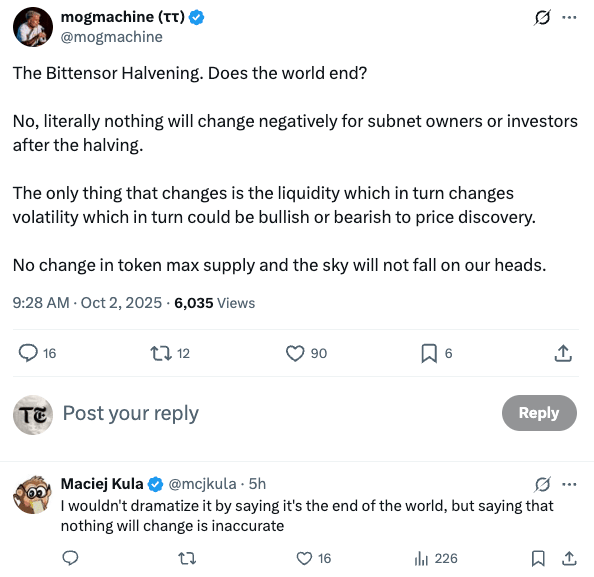- TAO Times ⚡️
- Posts
- TAO Times #42: All Eyes on the Halving
TAO Times #42: All Eyes on the Halving
SN75 in the spotlight, Subnet Growth Model, & subnet updates

TAO Times #42
TLDR;
Highlight of the Week: Community debate intensifies around the December TAO halving, with two competing proposals on synchronizing Alpha emissions vs. adjusting Alpha-in flows and redistributing excess TAO.
Ecosystem & Research: Michael White introduces the Subnet Growth Model (SGM), RJ from Unsupervised Capital highlights high-margin subnet strategies, and Subnet Magazine profiles Hippius as Bittensor’s leading decentralized storage subnet.
Subnet Updates: Apex (SN1) miners close the gap with validators, Taoshi (SN8) shifts to profit-based payouts and gears up Glitch’s public launch, Compute Horde (SN12) burns $1.28M in tokens and rolls out 2.0, 404-GEN (SN17) preps its 2D-to-3D feature, Gradients (SN56) transitions fully to tournament mining, and Ridges (SN62) cracks down on spammers while adding structural anti-spam protections.
Media & Community: Strong coverage of Hippius (SN75) with Mogmachine on Hash Rate and Keith Singery on alphanomics, plus Ridges (SN62) recognized for its low-cost, high-demand model. Ventura Labs interviews T-Slice on Minotaur (SN112), Revenue Search features Sportstensor (SN41), and VoidAI (SN27) details wrapped TAO subnets on Solana and beyond.
Development Updates: OpenDev Weekly shipped SDK v9.11.1 + btcli v9.12.0 with improved fee calculations and stake swap tools, SDK v10 nears release with breaking changes, and Proof of Stake migration advanced to Phase 2
Highlight of the Week
⚡️This week the community has been actively debating the long-term sustainability of Bittensor’s emissions mechanism, as the first TAO halving (Dec. 2025) draws near.
The focus: how asynchronous halving schedules for subnet ALPHA tokens distort incentives, liquidity, and long-term fairness between early and late subnet cohorts.
In the current dTAO system, subnets receive three token flows: TAO injections (τ_in), ALPHA injections (α_in), and ALPHA emissions to participants (α_out). While τ_in and α_in follow the global TAO halving clock, α_out follows each subnet’s local clock. This desynchrony compounds over time, creating distortions like accelerated ALPHA halvings, weaker liquidity for later subnets, slower Root dilution, and liquidation haircuts.
Left unresolved, the system risks disadvantaging new subnet launches and destabilizing long-term subnet economics.
Proposal 1: Global Synchronization (Maciej, Spacetime, & Michael)
Align α_out halvings with the global TAO schedule so all flows halve together.
Benefits: eliminates interval compression, equalizes liquidity across cohorts, removes haircut risk.
Trade-offs: lower max ALPHA supply for some cohorts; requires deciding between a hard-stop or Zeno-style emission tail.
Proposal 2: Adjusting α_in + Redistribution (Sillars & TaoStats)
Reduce α_in emissions in older subnets once α_halvings outpace TAO halvings.
Redistribute “excess TAO” to newer subnets to boost liquidity and extend OG subnet emissions.
Trade-offs: more complex redistribution, fairness debates, and less urgency (solution needed ~2029 vs. immediate).
With the clock ticking, the key question is how quickly the community can align on a path forward and implement a solution, if a solution is required at all. I recommend reading both proposals to understand the nuances outlined in each.
